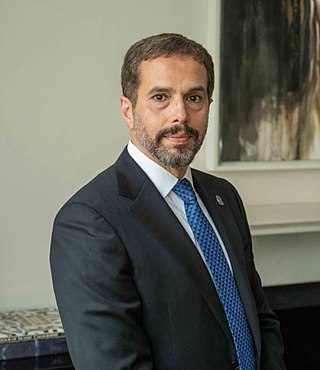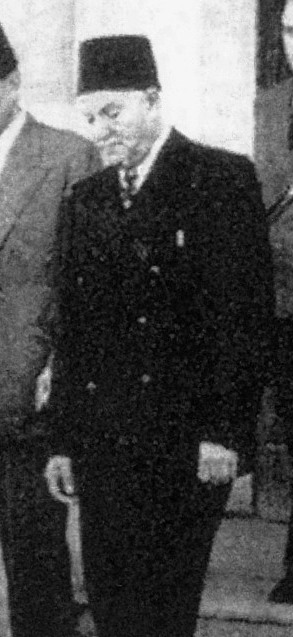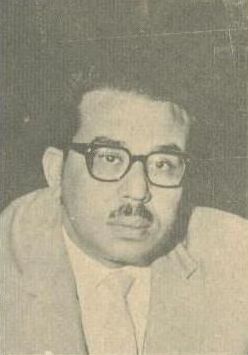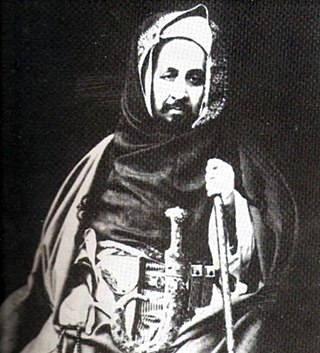
Muammar Muhammad Abu Minyar al-Gaddafi, also known as Colonel Gaddafi, was a Libyan politician, revolutionary, and political theorist. He was the de facto leader of Libya from 1969 to 2011, first as Revolutionary Chairman of the Libyan Arab Republic from 1969 to 1977 and then as the Brotherly Leader of the Great Socialist People's Libyan Arab Jamahiriya from 1977 to 2011. Initially ideologically committed to Arab nationalism and Arab socialism, he later ruled according to his own Third International Theory.

The Senusiyya, Senussi or Sanusi are a Muslim political-religious tariqa and clan in colonial Libya and the Sudan region founded in Mecca in 1837 by the Grand Senussi, the Algerian Muhammad ibn Ali as-Senussi. Senussi was concerned with what he saw as both the decline of Islamic thought and spirituality and the weakening of Muslim political integrity.

Muhammad Idris bin Muhammad al-Mahdi as-Senussi was a Libyan political and religious leader who was King of Libya from 24 December 1951 until his overthrow on 1 September 1969. He ruled over the United Kingdom of Libya from 1951 to 1963, after which the country became known as simply the Kingdom of Libya. Idris had served as Emir of Cyrenaica and Tripolitania from the 1920s until 1951. He was the chief of the Senussi Muslim order.

The University of Libya was a public university based in Tripoli and Benghazi, Libya. The university was established in 1955 and disestablished in 1973, when its colleges were split into two new universities: the University of Tripoli in Tripoli, and the University of Benghazi in Benghazi.

Sayyid Hasan ar-Rida al-Mahdi as-Senussi was the Crown Prince of the Kingdom of Libya from 26 October 1956 to 1 September 1969, when the monarchy was abolished.

Mohammed El Senussi is the son of Crown Prince Hasan as-Senussi of Libya, and of Crown Princess Fawzia bint Tahir Bakeer. Born in Tripoli, he is considered by Libyan royalists to be the legitimate heir to the Senussi Crown of Libya.

Hussein Yousef Maziq a Libyan politician was Prime Minister of Libya from 20 March 1965 to 2 July 1967. He was one of the most important men in the Kingdom era of Libya.

Mahmud al-Muntasir was the first Prime minister of Libya from March 29, 1951 to February 19, 1954, and again from January 20, 1964 to March 20, 1965. He was also the Minister of Foreign Affairs during his first term.

Mohieddin Fikini, last name also spelled Fekini, was the Prime Minister of Libya from 19 March 1963 to 22 January 1964. He was also the Minister of foreign affairs from 19 March 1963 to 22 January 1964.

Muhammad Sakizli was the Prime Minister of Cyrenaica from 18 March 1950 to 24 December 1951. He was later appointed as the Prime Minister of Libya from 19 February to 12 April 1954.

The Libyan Revolutionary Command Council was the twelve-person governing body that ruled the Libyan Arab Republic from 1969 to 1977. Its chairman was Muammar Gaddafi, who had the most influence.

Gazala, or ʿAyn al-Ġazāla, is a small Libyan village near the coast in the northeastern portion of the country. It is located 60 kilometres (37 mi) west of Tobruk.

Khalifa Mohammed Tillisi was a well-known Libyan historian, translator, and linguist.

Umar Abdullah el-Muhayshi, also transliterated as Omar al-Meheshi, was a Libyan army officer and a member of the Libyan Revolutionary Command Council that ruled Libya after the 1969 Libyan coup d'état.

Ahmed Sharif as-Senussi was the supreme leader of the Senussi order (1902–1933), although his leadership in the years 1917–1933 could be considered nominal. His daughter, Fatimah el-Sharif was the Queen consort of King Idris I of Libya.

During the early stages of the Libyan Civil War of 2011, the Gaddafi regime was still in power: but there was widespread withdrawal of support from that regime by influential persons and organisations within the country. Among those who no longer supported the regime, the main concern they expressed was what they regarded as its use of excessive force against peaceful protestors. There were many resignations by ministers of the governing council and other senior officials, diplomats posted abroad, and senior military officers. Islamic clerics, tribal leaders, and members of the former royal family expressed their opposition, while the two leading Libyan oil companies also withdrew support for the regime.
Abdullah Senussi is a Libyan national who was the intelligence chief and brother-in-law of Colonel Muammar Gaddafi. He was married to Gaddafi's sister-in-law.

From 1969 to early 2011, the politics of Libya were determined de facto by Muammar Gaddafi, who had been in power since his overthrow of the Kingdom of Libya in 1969.

Ahmed Gaddaf al-Dam is the cousin and aide of former Libyan leader Muammar Gaddafi. He is Libya's former Special Envoy to Egypt and a leading figure of the Gaddafi regime. He was a key member of Gaddafi's inner circle.


















